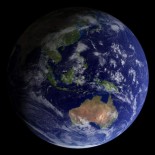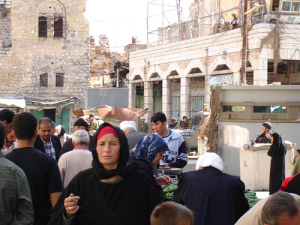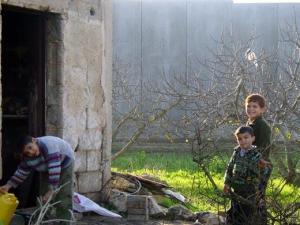Dr H. in the Holy Land VII: Hebron and the Christian Peacemaker Teams
 Hebron is a town that lies to the south of Bethlehem in the West Bank. In Arabic it is known as Al Khalil. We went by bus and the drive from Bethlehem south was beautiful, a lot of arable land and the green vegetation was lush making a change from the arid scenery that marks the horizon elsewhere. Scattered amongst the hills there were settlements.
Hebron is a town that lies to the south of Bethlehem in the West Bank. In Arabic it is known as Al Khalil. We went by bus and the drive from Bethlehem south was beautiful, a lot of arable land and the green vegetation was lush making a change from the arid scenery that marks the horizon elsewhere. Scattered amongst the hills there were settlements.
Hebron is full of hustle and bustle and in fact I was surprised to see it so lively. The last stop on the bus was Bab-iz-Zawieh. After getting off the bus we went to meet our guide for the day. Headed towards the old city, there were rows upon rows of closed metal doors – here it is common that the shops in the old cities have often green or blue iron doors that come across the whole shop front. As we walked towards the old city and the further in we went, more and more shops were bolted and closed, I wondered how long they had been closed for – months, years? From the market area of where the bus has dropped us off it felt like we were walking into another world of destitution. People were delighted to see foreigners and always shouted out “Ahlan wa sahlan” or “welcome”. We were met by a man who despite his grey hair, walking stick and slightly stooped posture was as fit as a hare. He beamed at us clearly glad to see us and said follow me in an English accent.
He explained that Hebron was a significant site for Jews because Abraham, Jacob and Isaac were all buried there as well as their wives. He took us up to a checkpoint and I looked on in fear but he said, “No no, don’t worry, just walk through like you own the place!”
The checkpoint is known as Duboyya street checkpoint and it leads onto Shuhadah Street – this used to be one of the main streets in the old city but is now colonized by Israeli settlers. There was a heavy military presence with security cameras stationed everywhere positioned on top of shops. As you walk down the street you feel that all eyes are on you as well as cameras, shops are closed and Stars of David have been graffitied upon the doors.
On the left as you continue up the street is Beit Hadassah; it was built 100 years ago as a hospital but is now a settlement with settlers living inside and a synagogue has also been built. Further up is the old Arab bus station which has been converted into the military base. There is also the back of the Yeshiva which is a new modern building with marble-quarried creamed stones but when you look closer you can see that the foundations are still of the old Palestinian building. On the right of the road is the Arab cemetery and apparently there are talks to make this into a main road for the settlers so that they don’t have to share the road with the Palestinians. We walked up through the archaeological sites and our guide read verses from the Bible to us and related these to the sites.
Christian Peacemakers Teams (CPT) do some remarkable work here in Hebron. Every morning they wake up and chaperone the children to school at 7:30 am. The children have to come through the same checkpoint to go to their school. The chaperoning is essential because if they don’t get chaperoned then they will get stoned and verbally abused by the settlers. Or teachers are deliberately held up so that their classes can’t start on time. Following this, CPT have prayers together and then plan what they are going to do for the rest of the day. Their foreign presence helps to deter some of the atrocities that are carried out. They have also helped shepherds so that their flock can graze.
As we continued our tour up to the top, we came across another watchtower and another military base, at the entrance of a road which had another settlement on it – Ramat Eshai. There were now only 2 Palestinian families living there as the rest had fled. Again we were greeted by soldiers who told us to go back to London, a stark contrast between all the Palestinians who always shout out “welcome”. They are all in their early 20s pointing large rifles at us.
Ramat Eshai has been there since 1986. Hashim invited us into his house. His front door is on this road but he has been unable to use it. We clamber up a mound and through some broken stones into his back yard. It’s a beautiful courtyard with grapes hanging down from vine leaves shading us. As we walk round from the back to the front, I see plastic cola bottles filled with urine, a potty, rubbish, nappies, sharp pieces of broken glass and even a washing machine. “These are all the things that settlers have thrown down on me.. the washing machine nearly killed me”.
Looking beyond there are stairs leading up to the street and at the top of it is barbed wire. Hashim can no longer use his front door and in fact has not done so for the last several years. There is also a small olive grove and again as I stepped out he warned me to come back, stating that the settlers will throw things at me and it’s not safe. He has not harvested his olives since 2000. Last year he had a resolution from the high court granting him permission to pick olives off his own trees on his own land. However when he got there – the settlers had taken all the olives. B’Tselem have a video on this.
I looked at his grape trees and vines and the tree trunks were growing up from the ground but then sliced in half. The upper half of the trunks were being held in mid air by the vines that were intertwined from up above. The settlers had done this. As he led me to this front door he showed me bullet holes in the wall on top of his door. He said that he still had no landline in his house as his telephone line had been cut in 2003 and the main line is next to the settlement. Every 21 days his water is only turned on for 1 day. He was so eager to tell me atrocities.. that I could not bear to hear.
He told me about the 3 year curfew that they had from 2000 to 2003 where his family were not even allowed into the yard, except for 2 hours per month to buy food. I think that even if you ran to the shops and filled up your trolley with food and then ran back it would not be enough to feed a family for a month.
He tells me about a settler who put a stone in his nephew’s mouth and ground his jaw from left to right so that his teeth were damaged. He then grins at me and shows me 2 gaping holes in his canines where he too lost his teeth when a settler broke his teeth with the base of his gun. All the windows in his house have 3 different layers of bars and grids to protect him and his family. He shows me his 5 year old son Younis, he was stoned 4 months ago and then shows me the stitches to his right eye brow. They are not even allowed a kitchen knife and he brings out the largest knife he has in the kitchen – equivalent to a butter knife!
There’s so much more to say but as I read my notes realize it’s too awful to put into words…
As we left his house and walked back through Duboyya street checkpoint and through the old city I looked up towards the sky and saw wire netting protecting the people underneath it and their shops. Sharp pieces of glass, bottles, metal and rubbish were caught between the metal grid – clearly with the intent to do damage.
As we walked down a main road, an Israeli car sped past and a kid wound down the window and spat at my sister…
Leaving Hebron left me with a lot to think about, it left me in shock and subdued. I debate Hashim’s decision to continue living there with his 3 young children and his right to live in his house – it can’t be easy.
For more on the Christian Peacemaker Teams and their work in Palestine, please click on http://www.cpt.org and http://www.cpt.org/work/palestine respectively.
About CPT
Christian Peacemaker Teams (CPT) arose from a call in 1984 for Christians to devote the same discipline and self-sacrifice to nonviolent peacemaking that armies devote to war. Enlisting the whole church in an organized, nonviolent alternative to war, today CPT places violence-reduction teams in crisis situations and militarized areas around the world at the invitation of local peace and human rights workers. CPT embraces the vision of unarmed intervention waged by committed peacemakers ready to risk injury and death in bold attempts to transform lethal conflict through the nonviolent power of God’s truth and love.



Thanks Ann and the good Dr. H for this series, I hope there is more. I think the everyday wearing down of people is something people globally can understand and empathise with (in spirit if not in actuality of degree) and it’s clear this is a policy with specific ends in mind- To drive people out by sheer grinding misery and this kind of reportage really conveys the reality and is a vital endeavour.
Appreciate your comment, Rick, as does Dr H.
Thanks for speaking of CPT and our work to folks. We need to continue speaking out the Truth of what’s happening!
Blessings to you,
Tarek Abuata
CPT Palestine Support Coordinator
Thanks for coming by Tarek. CPT’s work and courage is extremely moving, inspiring, and indispensable. All the best to you.